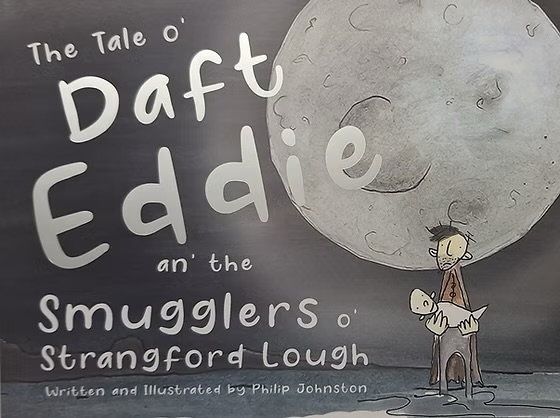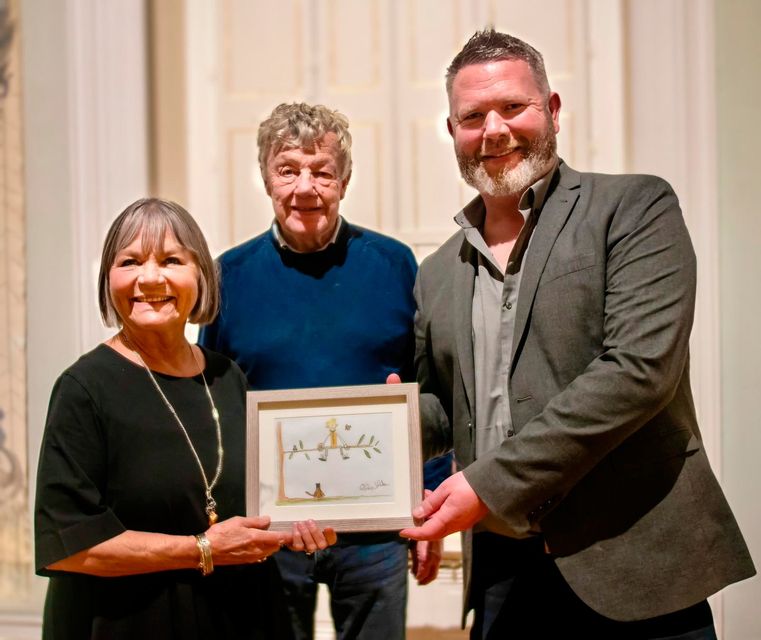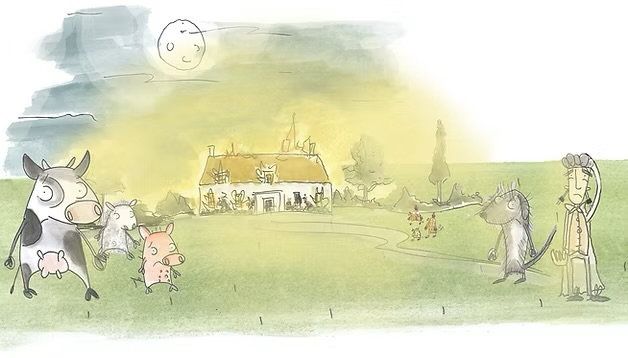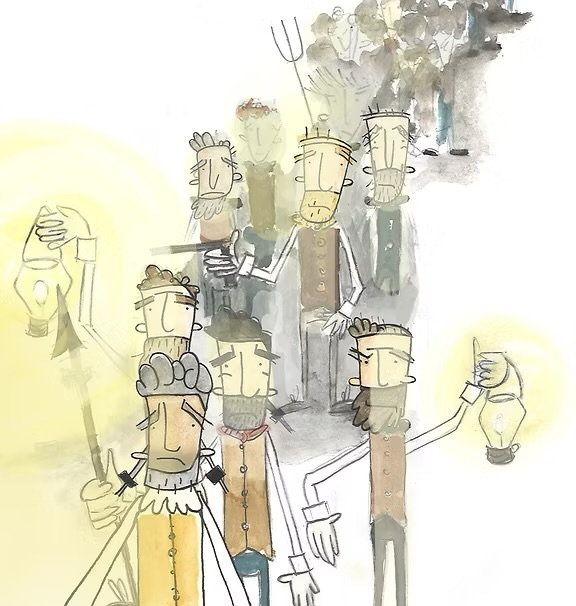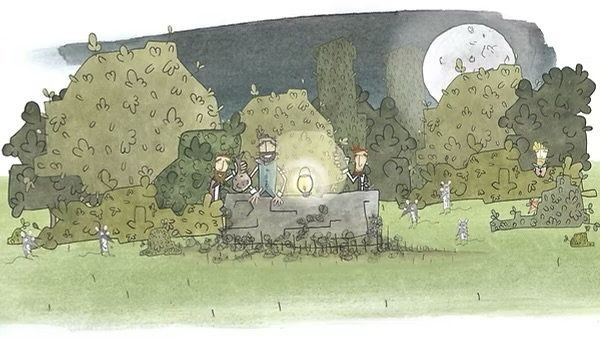A special needs teacher from Co Down who revived the forgotten ‘Tale o’ Daft Eddie an’ the Smugglers o’ Strangford Lough’ is delighted his new book is sparking an interest in Ulster-Scots heritage and hopes it will inspire marginalised pupils.
Philip Johnston (43), who lives in Ballyhalbert, launched the illustrated publication at Ballywalter Park in October at the request of the period mansion’s owners Lord and Lady Dunleath.
The book, which chronicles the exploits and explores the places Daft Eddie visited on a nail-biting adventure believed to have taken place in the 18th Century, also features another character who accompanied the peculiar protagonist.
Tale o’ Daft Eddie an’ the Smugglers o’ Strangford Lough.
“Ballywalter Park was once known as Springvale and it was the home of Major Matthews who played an influential role in the story,” Mr Johnson explained.
“I reached out to the owners when I was researching and visiting the sites depicted in the original story and they hadn’t heard of it before.
“When I told them they said I have to do the launch there – they were both very excited that the people in the story were connected to the property.”
First published as a serial in the North Down Herald and Bangor Gazette back in 1889, ‘Daft Eddie or the Smugglers of Strangford: A Tale of Killinchy’ was written by W.G Lyttle and based on actual events during the late 1700s and early 1800s.
It chronicle the activities of local bandits known as ‘The Merry Hearts of Down’ whose crimes included kidnap, extortion and murder.
Eventually a hero emerges from Mahee Island to shadow the gang’s every move and help in the search for an abducted magistrate and his daughter.
“Daft Eddie would have been considered to have special needs if he was living today,” Mr Johnston explained.
“The term daft shouldn’t be confused with eejit.
Lord and Lady Dunleath being presented with a signed illustration by Philip Johnston
“Today people might say that someone ‘isn’t quite right’ or ‘has a wee want’, but back then they would have said you were ‘a wee daftie’.
“So here we have a guy who became the hero of his time even though he was stigmatised and marginalised by his contemporaries.
“I love that.”
The author of the reimagined tale said that, like most others, he was not overly familiar with the story that all unfolds on the Ards peninsula –despite his grandmother telling him yarns about the smugglers when he visited her as a child in Killyleagh.
Mr Johnston opined the fact that locals – including those who flock to the popular Daft Eddy’s Bar & Restaurant in Killinchy – don’t know the full story.
“I became curious about the origins during the first lockdown and absolutely loved what I found – I remember just being struck by the fact that this wonderful tale took place where I live and thought ‘this is too good of a story to be lost in time’,” he explained.
The married father-of-three who grew up in Bangor was captivated by Lyttle’s book, penned in Ulster-Scots, and set off with his children to explore hidden caves and grave yards with one mission in mind – to resurrect the lost tale.
“From Killyleagh to Portaferry to the lead mines at the top of the lough, It covers to whole peninsula and all happened at a turbulent time when people were rising up against the rulers of the day,” Mr Johnston said.
“But nobody knows about it.”
Illustration from the Tale o’ Daft Eddie an’ the Smugglers o’ Strangford Lough.
It took two-and-a-half years for the teacher to rewrite the story and put it into rhyme and create a website full of valuable educational resources.
The teacher-turned-author also believes rediscovering local heritage has the potential to boost tourism.
“The peninsula has such a rich history and I think it’s worthy of being showcased,” Mr Johnston said.
“It’s time to make the lough a bit more exciting.
“Young people need to be educated on this.
“If it was any other culture the story would be out there.
“We aren’t good at pushing Ulster Scots culture but there are so many stories.”
Following in the footsteps of Wesley Greenhill Lyttle, whose alter ego Robin – a jovial country farmer who regaled his audiences in Ulster-Scots, Mr Johnston said it feels fitting that he should be the one to breathe new life into an old story.
Beloved entertainer and former newspaper editor Lyttle is buried in Bangor Abbey where a memorial plinth describes him as “a man of rare natural gifts”.
“He raised himself to a high position among the journalists of Ireland,” the tribute continues.
“He was a brilliant and graceful writer, a true humourist and an accomplished poet.
Illustration from the Tale o’ Daft Eddie an’ the Smugglers o’ Strangford Lough.
“Robin was a kind friend, a genial companion and a true son of County Down.”
The late writer is most famous for his novel Betsy Gray which was published in 1888 and tells the story of the heroine riding into the Battle of Ballynahinch dressed in a green silk dress and brandishing a brightly burnished sword – it remains compelling more than two centuries after the 1798 rebellion in Ireland.
While the facts of her existence are in contention, W.G Lyttle was convinced of her identity and believed she hailed from Gransha, near Bangor.
“It might be my next book,” Mr Johnston said.
“It feels right that I’m a Bangor man trying to revive these stories.
“I want to do what W.G Lyttle did 200 years ago – he was all about celebrating the culture of the time but so much has been lost because everything has been reduced to green and orange.”
Determined to make his county’s cultural gems shine again, Mr Johnston is excited about the potential ripple effect of his debut book which has piqued the interest of Tourism NI with copies available in visitor centres in Newtownards, Bangor, Newcastle as well as Exploris Aquarium in Portaferry.
Online orders are also flooding in from around the world including country’s such as New Zealand, South Africa and Australia.
Illustration from the Tale o’ Daft Eddie an’ the Smugglers o’ Strangford Lough.
The author has been “completely blown away” by the initial success and level of appreciation.
“I’ve been contacted by parents saying how much their children are enjoying learning new words and phrases and a number of schools are interested in integrating it into the curriculum,” Mr Johnston said.
“It’s such a great way to introduce young people to what was going on in Ireland at that time and how Northern Ireland came to be and give them insight to how people lived and spoke 2,000-years-ago.
“Young people are so disconnected from their ancestry and the history that the peninsula is steeped in is a great way to reconnect them.”
Further information can be found at allthingseddie.com
